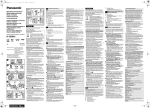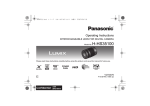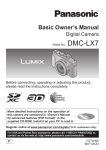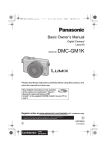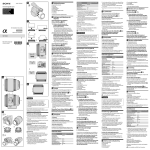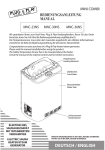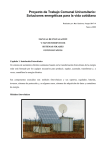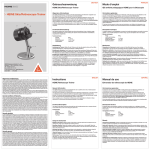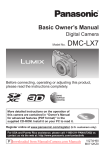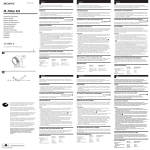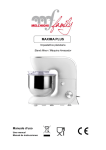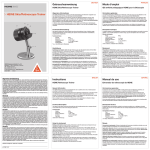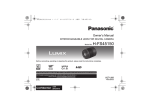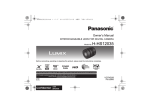Download H-FS12032 - Panasonic Store
Transcript
VQT5D07_E.fm 1 ページ 2013年10月2日 水曜日 午後3時46分 ENGLISH Operating Instructions/ Bedienungsanleitung/ Mode d’emploi/ Instrucciones de funcionamiento INTERCHANGEABLE LENS FOR DIGITAL CAMERA WECHSELOBJEKTIV FÜR DIGITAL-KAMERA OBJECTIF INTERCHANGEABLE POUR APPAREIL PHOTO NUMÉRIQUE ÓPTICA INTERCAMBIABLE PARA CÁMARA DIGITAL Model No./Model Nr./Modèle n°/Modelo N. H-FS12032 1 VYF3562 2 VFC4605 Please read these instructions carefully before using this product, and save this manual for future use. 1 2 3 4 Disposal of Old Equipment Only for European Union and countries with recycling systems This symbol on the products, packaging, and/or accompanying documents means that used electrical and electronic products must not be mixed with general household waste. For proper treatment, recovery and recycling of old products, please take them to applicable collection points in accordance with your national legislation. By disposing of them correctly, you will help to save valuable resources and prevent any potential negative effects on human health and the environment. For more information about collection and recycling, please contact your local municipality. Penalties may be applicable for incorrect disposal of this waste, in accordance with national legislation. Information for Your Safety Keep the unit as far away as possible from electromagnetic equipment (such as microwave ovens, TVs, video games, radio transmitters, highvoltage lines etc.). • Do not use the camera near cell phones because doing so may result in noise adversely affecting the pictures and sound. • If the camera is adversely affected by electromagnetic equipment and stops functioning properly, turn the camera off and remove the battery and/or the connected AC adaptor. Then reinsert the battery and/or reconnect the AC adaptor and turn the camera on. The lens can be used with a digital camera compatible with the lens mount standard for the “Micro Four ThirdsTM System”. • It cannot be mounted on the Four ThirdsTM mount specification camera. • The digital camera illustrations in these operating instructions show DMC-GM1 as an example. • The appearance and specifications of products described in this manual may differ from the actual products you have purchased due to later enhancements. • Micro Four ThirdsTM and Micro Four Thirds Logo marks are trademarks or registered trademarks of Olympus Imaging Corporation, in Japan, the United States, the European Union and other countries. • Four ThirdsTM and Four Thirds Logo marks are trademarks or registered trademarks of Olympus Imaging Corporation, in Japan, the United States, the European Union and other countries. • G MICRO SYSTEM is an interchangeable lens type digital camera system of LUMIX based on a Micro Four Thirds System standard. • Other names of systems and products mentioned in these instructions are usually the registered trademarks or trademarks of the manufacturers who developed the system or product concerned. ∫ Lens Care • Sand and dust can damage the lens. Make sure that no sand or dust gets inside the lens or the terminals when using the lens on a beach, etc. • This lens is not waterproof. If drops of water get onto the lens, wipe the lens with a dry cloth. • Do not press the lens with excessive force. • When there is dirt (water, oil, and fingerprints, etc.) on the surface of the lens, the picture may be affected. Lightly wipe the surface of the lens with a soft, dry cloth before and after taking pictures. • Do not place the lens mount facing downwards. Do not allow the lens contact points 1 to become dirty. (See illustration ) 2 ∫ About Condensation (Fogging of the Lens) 3 • Condensation occurs when there are differences in temperature and humidity as described below. Condensation can cause the lens to become dirty and lead to mold and malfunctioning, so exercise caution in the following situations: – When the camera is brought indoors from outside during cold weather – When the camera is brought into an air-conditioned car – When cold air from an air conditioner is directly blown onto the lens – In humid places • Put the camera into a plastic bag to allow it to acclimatize to the surrounding temperature in order to prevent condensation. If condensation occurs, turn the power off and leave it for about two hours. Once the camera acclimatizes to the surrounding temperature the condensation will go away naturally. B Panasonic Corporation Web Site: http://panasonic.net Panasonic Corporation 2013 E VQT5D07 F1013WT0 until 2013/10/7 1 2 Lens Cap Lens Rear Cap (The lens rear cap and lens cap are attached to the interchangeable lens at the time of purchase.) -If you see this symbol- Precautions 1 Product numbers correct as of October 2013. These may be subject to change. Supplied Accessories [Inspection to be performed when you unpack the unit] When removing the unit from its packing box, check that the main unit and the supplied accessories are there and also check their external appearance and functions to verify that they have not sustained any damage during distribution and transportation. If you discover any trouble, contact your vendor before using the product. C 1 2 Names and Functions of Components Lens surface Zoom ring Rotate the zoom ring when you wish to take large (tele) or wide (wide angle) pictures. (35 mm film camera equivalent: 24 mm to 64 mm) Lens fitting mark Contact points 3 4 Manual Focus with the lens is possible only with a model that supports the lens. Refer to the support website below for details: http://panasonic.jp/support/global/cs/dsc/ Note • When flash recording with a close subject, the light of the flash will be blocked by the lens and part of the picture may be dark. Check the distance from the subject when recording. • When recording on the wide-angle side and using the flash, the periphery of the screen may darken. In such cases, we recommend using the external flash. • If you zoom after focusing, focusing errors may occur. After zooming, please perform the focusing again. D Troubleshooting Attaching/Detaching the Lens • Refer also to the camera’s operating instructions for attaching and detaching the lens. • Check that the camera is turned off. • Remove the lens rear cap from the lens. (See illustration ) • Attach and remove the lens only when the lens barrel is retracted. ∫ Attaching the Lens (See illustration ) Align the lens fitting marks A on the camera body and the lens and then rotate the lens in the direction of the arrow until it clicks. • Do not press the lens release button B when you attach a lens. • Do not try to attach the lens when holding it at an angle to the camera body as the lens mount may get scratched. • Check that the lens is attached correctly. ∫ Detaching the Lens (See illustration ) While pressing on the lens release button B, rotate the lens toward the arrow until it stops and then remove. • When rotating the lens, hold C, the portion near the base of the lens. • Attach the lens rear cap so that the lens contact point does not get scratched. • Attach the body cap to the camera so no dirt or dust will get inside the main unit. E Do not carry the unit when it is still attached to the camera body. • Under no circumstances should the unit be stored in any of the following locations since doing so may cause problems in operation or malfunctioning. – In direct sunlight or on a beach in summer – In locations with high temperatures and humidity levels or where the changes in temperature and humidity are acute – In locations with high concentrations of sand, dust or dirt – Where there is fire – Near heaters, air conditioners or humidifiers – Where water may make the unit wet – Where there is vibration – Inside a vehicle • Refer also to the operating instructions of the digital camera. • When the unit is not going to be used for a prolonged period, we recommend storing with a desiccant (silica gel). Failure to do so may result in performance failure caused by mold, etc. It is recommended that you check the unit’s operation prior to use. • Do not leave the lens in contact with rubber or plastic products for extended periods of time. • Do not touch the lens contact point. Doing so can cause failure of the unit. • Do not disassemble or alter the unit. Do not use benzine, thinner, alcohol or other similar cleaning agents to clean the lens glass or exterior cabinet. • Using solvents can damage the lens or cause the paint to peel. • Wipe off any dust or fingerprints with a soft, dry cloth. • Wipe off any dirt or dust on the zoom ring with a dry, dustless cloth. • Do not use a household detergent or a chemically treated cloth. Recording Preparations and How to Retract the Lens ∫ Recording Preparations Rotate the zoom ring in the direction of arrow 1 from position A (the lens is retracted) to position B (12 mm to 32 mm) to extend the lens. • When the lens barrel is retracted, images cannot be recorded. • Make sure to remove the lens cap. ∫ How to Retract the Lens Rotate the zoom ring in the direction of arrow 2 from position B (12 mm to 32 mm) to position A to retract the lens. • When you are not recording images, we recommend that you retract the lens. ∫ Attaching Filters • Vignetting may occur if using 2 or more MC protectors (optional: DMW-LMCH37), PL filters (optional: DMWLPL37, DMW-LPLA37) or ND filters (optional: DMWLND37), or if using thick protectors and/or filters. • The filter may become impossible to remove if excessively tightened, so please refrain from tightening it too strongly. • It is possible to attach the lens cap with the filter already attached. • You cannot attach a conversion lens or adaptor to this lens. A filter may be used, but attaching any other element may cause damage to the lens. Cautions for Use Take care not to drop or knock the lens. Also take care not to put a lot of pressure on the lens. • Take care not to drop the bag that you inserted the lens in as it may strongly shock the lens. The camera may stop operating normally and pictures may no longer be recorded. Also, the lens may be damaged. When using pesticides and other volatile substances around the camera make sure that they do not get onto the lens. • If such substances get onto the lens they can damage the exterior case or cause the paint to peel. A sound is heard when the camera is turned on or off. • This is the sound of lens or aperture movement and is not a malfunction. When this lens is attached to digital camera, stabiliser function cannot be turned off or stabiliser function does not work. • The Optical Image Stabiliser function of this lens only works correctly with supported cameras. > When older Panasonic digital cameras (DMC-GF1, DMC-GH1, DMC-G1) are used, [Stabilizer] in the [Rec] mode menu cannot be set to [OFF]. It is recommended to update the firmware of the digital camera at the following website. http://panasonic.jp/support/global/cs/dsc/download/ > When using this lens with another make of digital cameras, contact the respective company about details. Specifications Specifications are subject to change without notice. INTERCHANGEABLE LENS FOR DIGITAL CAMERA “LUMIX G VARIO 12– 32 mm/F3.5– 5.6 ASPH./ MEGA O.I.S.” Focal length f=12 mm to 32 mm (35 mm film camera equivalent: 24 mm to 64 mm) Aperture type 7 diaphragm blades/circular aperture diaphragm Aperture range F3.5 (Wide) to F5.6 (Tele) Minimum aperture value F22 Lens construction 8 elements in 7 groups (3 aspherical lenses, 1 ED lenses) In focus distance 0.2 m to ¶ [from the focus distance reference line] (focal length 12 mm to 20 mm), 0.3 m to ¶ [from the focus distance reference line] (focal length 21 mm to 32 mm) Maximum image magnification 0.13k (35 mm film camera equivalent: 0.26k) Optical image stabiliser Available [O.I.S.] switch None (Setting of the [Stabilizer] is done in [Rec] mode menu by LUMIX digital cameras.) Mount “Micro Four Thirds Mount” Angle of view 84x (Wide) to 37x (Tele) Filter diameter 37 mm Max. diameter Approx. 55.5 mm Overall length Approx. 24 mm (from the tip of the lens to the base side of the lens mount when the lens barrel is recessed) Mass Approx. 70 g DEUTSCH Bitte lesen Sie diese Anleitung vor der Inbetriebnahme dieses Produkts aufmerksam durch, und bewahren Sie dieses Handbuch für spätere Bezugnahme griffbereit auf. -Bedeutung des nachstehend abgebildeten SymbolsEntsorgung von Altgeräten Nur für die Europäische Union und Länder mit Recyclingsystemen Dieses Symbol, auf den Produkten, der Verpackung und/oder den Begleitdokumenten, bedeutet, dass gebrauchte elektrische und elektronische Produkte nicht in den allgemeinen Hausmüll gegeben werden dürfen. Bitte führen Sie alte Produkte zur Behandlung, Aufarbeitung bzw. zum Recycling gemäß den gesetzlichen Bestimmungen den zuständigen Sammelpunkten zu. Indem Sie diese Produkte ordnungsgemäß entsorgen, helfen Sie dabei, wertvolle Ressourcen zu schützen und eventuelle negative Auswirkungen auf die menschliche Gesundheit und die Umwelt zu vermeiden. Für mehr Informationen zu Sammlung und Recycling, wenden Sie sich bitte an Ihren örtlichen Abfallentsorgungsdienstleister. Gemäß Landesvorschriften können wegen nicht ordnungsgemäßer Entsorgung dieses Abfalls Strafgelder verhängt werden. Setzen Sie sich, sollten Sie Störungen feststellen, vor dem Gebrauch des Gerätes mit Ihrem Händler in Verbindung. Stand der Produktnummern: Oktober 2013. Änderungen bleiben vorbehalten. 1 2 Objektivdeckel Hinterer Objektivdeckel (Beim Kauf sind der hintere Objektivdeckel und der Objektivdeckel auf das Wechselobjektiv aufgesetzt.) C 1 2 Linsenfläche Zoomring Drehen Sie am Zoomring, wenn Sie Aufnahmen mit Tele oder Aufnahmen mit Weitwinkel machen möchten. (Kleinbild-Äquivalent: 24 mm bis 64 mm) Markierung zum Ansetzen des Objektivs Kontaktpunkt 3 4 Der manuelle Fokus ist mit dem Objektiv nur in Verbindung mit einem Modell möglich, welches das Objektiv unterstützt. Detaillierte Informationen finden Sie auf der unten genannten Support-Website: http://panasonic.jp/support/global/cs/dsc/ Informationen für Ihre Sicherheit Halten Sie das Gerät so weit wie möglich von Geräten und Einrichtungen fern, die elektromagnetische Felder erzeugen (wie Mikrowellengeräte, Fernsehgeräte, Videospielgeräte, Funksender, Hochspannungsleitungen usw.). • Verwenden Sie die Kamera nicht in der Nähe von Mobiltelefonen. Es könnten sonst Bild- und Tonstörungen auftreten. • Wenn die Kamera durch elektromagnetische Felder anderer Geräte gestört wird und Fehlfunktionen auftreten, schalten Sie die Kamera aus. Nehmen Sie den Akku heraus und/oder trennen Sie das Netzadapter ab. Setzen Sie den Akku dann wieder ein und/oder stecken Sie das Netzadapter wieder ein und schalten Sie die Kamera ein. Das Objektiv kann mit Digitalkameras verwendet werden, deren Objektivfassung mit dem “Micro Four Thirds™ System”-Standard kompatibel ist. • Objektive dieser Ausführung lassen sich nicht auf Kameras mit Four-Thirds™-Bajonett aufsetzen. • Die Erläuterungen zur Digitalkamera in dieser Bedienungsanleitung beziehen sich als ein Beispiel auf DMC-GM1. • Ausstattung und technische Daten der von Ihnen erworbenen Produkte können aufgrund technischer Weiterentwicklungen von der Ausstattung und den technischen Daten der in diesem Handbuch beschriebenen Produkte abweichen. • Micro Four Thirds™ und die für Micro Four Thirds verwendeten Logos sind Markenzeichen oder eingetragene Markenzeichen der Olympus Imaging Corporation in Japan, den USA, der EU und anderen Ländern. • Four Thirds™ und die für Four Thirds verwendeten Logos sind Markenzeichen oder eingetragene Markenzeichen der Olympus Imaging Corporation in Japan, den USA, der EU und anderen Ländern. • Das G MICRO SYSTEM ist ein Digitalkamerasystem aus der LUMIX-Reihe mit Wechselobjektiven auf Grundlage des Micro-Four-Thirds-Standards. • Andere Namen von Systemen oder Produkten welche in dieser Bedienungsanleitung genannt werden, sind normalerweise Warenzeichen oder eingetragene Warenzeichen der Hersteller dieser Produkte oder Systeme. Vermeidung von Störungen ∫ Objektivpflege • Sand und Staub können das Objektiv beschädigen. Achten Sie darauf, dass kein Sand oder Staub auf Objektiv oder Anschlüsse gelangt, wenn Sie die Kamera im Freien, z.B. am Strand, verwenden. • Dieses Objektiv ist nicht wasserdicht. Wenn Regenwasser oder anderes Wasser auf das Objektiv spritzt, wischen Sie es mit einem trockenen Tuch ab. • Üben Sie keinen zu starken Druck auf das Objektiv aus. • Schmutz auf dem Objektiv (Wasser, Öl, Fingerabdrücke usw.) kann zu schlechteren Bildern führen. Wischen Sie die Objektivoberfläche vor und nach dem Fotografieren vorsichtig mit einem weichen, trockenen Tuch ab. • Richten Sie die Objektivfassung nicht nach unten. Achten Sie darauf, dass der Kontaktpunkt der Objektivfassung 1 nicht verschmutzen. (Siehe Abbildung ) ∫ Hinweise zu Kondensation (Beschlagen des Objektivs) • Kondensation entsteht, wenn sich Umgebungstemperatur oder Luftfeuchte wie unten beschrieben ändern. Da Kondensation zu Flecken auf dem Objektiv, Pilzbefall und Fehlfunktionen führen kann, müssen Sie in folgenden Fällen auf Anzeichen von Kondensation achten: – Die Kamera wird bei kaltem Wetter von draußen nach drinnen gebracht – Die Kamera wird in ein klimatisiertes Auto gebracht – Eine Klimaanlage bläst kalte Luft direkt auf das Objektiv – Die Kamera wird bei hoher Luftfeuchte verwendet • Sie vermeiden Kondensation, wenn Sie die Kamera in einer geschlossenen Plastiktüte transportieren und diese erst dann öffnen, wenn sich die Kamera an die Umgebungstemperatur angepasst hat. Wenn sich Kondensation bildet, schalten Sie die Kamera aus und lassen Sie sie für etwa zwei Stunden ausgeschaltet. Die Kondensation baut sich während der Anpassung der Kamera an die Umgebung auf natürlichem Wege ab. B Beiliegendes Zubehör [Kontrollen, die beim Entfernen der Verpackung des Geräts vorzunehmen sind] Prüfen Sie beim Entnehmen des Gerätes aus seinem Karton, ob das Hauptgerät und sein beiliegendes Zubehör vorhanden sind. Kontrollieren Sie deren äußeres Aussehen und ihre Funktionsweise, um zu prüfen, dass es während des Vertriebs und Transports nicht zu Beschädigungen gekommen ist. Bezeichnungen und Funktionen der einzelnen Kamerateile Hinweis • Wenn Sie ein Motiv nah an der Kamera mit Blitz aufnehmen, blockiert das Objektiv das Licht vom Blitz, so dass Teile des Bildes dunkel werden können. Achten Sie bei diesen Aufnahmen daher auf ausreichenden Abstand zum Motiv. • Beim Fotografieren im Weitwinkel und bei Verwendung des Blitzlichts, kann sich der Rand des Bildschirms verdunkeln. In solchen Fällen empfehlen wir die Verwendung eines externen Blitzlichts. • Wenn Sie nach dem Fokussieren den Zoom verwenden, kann es zu Fokussierungsproblemen kommen. Bitte stellen Sie nach dem Zoomvorgang erneut scharf. D Objektiv ansetzen/abnehmen • Informationen zum Aufsetzen und Abnehmen des Objektivs finden Sie auch in der Bedienungsanleitung der Kamera. • Stellen Sie sicher, dass die Kamera ausgeschaltet ist. • Entfernen Sie den hinteren Objektivdeckel vom Objektiv. (Siehe Abbildung ) • Achten Sie darauf, das Objektiv nur anzubringen und zu entfernen, wenn der Objektivtubus eingefahren ist. ∫ Das Objektiv aufsetzen (Siehe Abbildung ) Richten Sie die roten Markierungen A zum Ansetzen des Objektivs auf Kameragehäuse und Objektiv aneinander aus und drehen Sie das Objektiv in Pfeilrichtung, bis es hörbar einrastet. • Drücken Sie nicht die Objektivfreigabetaste B wenn Sie ein Objektiv anschließen. • Versuchen Sie niemals, das Objektiv schräg zum Gehäuse anzusetzen, da die Objektivfassung beschädigt werden könnte. • Überprüfen Sie, ob das Objektiv richtig aufgesetzt ist. ∫ Das Objektiv abnehmen (Siehe Abbildung ) Drehen Sie beim Betätigen der Objektivfreigabetaste B das Objektiv in Pfeilrichtung bis zum Anschlag und entfernen Sie es. • Wenn Sie das Objektiv drehen, halten Sie C, den Bereich in der Nähe der Objektivbasis. • Setzen Sie den hinteren Objektivdeckel auf, um die Kontakte der Objektivfassung nicht zu beschädigen. • Setzen Sie den Gehäusedeckel der Kamera auf, damit kein Schmutz oder Staub ins Kamerainnere gelangen kann. E Aufnahmevorbereitungen und Einfahren des Objektivs ∫ Aufnahmevorbereitungen Drehen Sie den Zoomring in Pfeilrichtung 1 von Position A (das Objektiv ist eingefahren) nach Position B (12 mm bis 32 mm), um das Objektiv auszufahren. • Wenn der Objektivtubus eingefahren ist können keine Bilder aufgenommen werden. • Achten Sie darauf, den Objektivdeckel zu entfernen. ∫ Einfahren des Objektivs Drehen Sie den Zoomring in Pfeilrichtung 2 von Position B (12 mm bis 32 mm) nach Position A, um das Objektiv einzufahren. • Wir empfehlen, das Objektiv einzufahren, wenn Sie keine Bilder aufnehmen. ∫ Filter aufsetzen • Ein Vignettierungseffekt kann auftreten, wenn 2 oder mehr MCSchutzfilter (Sonderzubehör: DMW-LMCH37), PL-Filter (Sonderzubehör: DMW-LPL37, DMW-LPLA37) oder ND-Filter (Sonderzubehör: DMW-LND37) verwendet werden, oder wenn dicke Schutzfilter und/oder Filter verwendet werden. • Der Filter lässt sich eventuell nicht mehr abnehmen, wenn er zu fest angezogen wird. Gehen Sie daher vorsichtig vor. • Der Objektivdeckel kann auch aufgesetzt werden, wenn der Filter bereits angebracht ist. • Auf dieses Objektiv lassen sich weder Vorsatzlinsen noch Adapter aufsetzen. Die Verwendung von Filtern ist möglich, das Aufsetzen anderer Komponenten dagegen kann zu einer Beschädigung des Objektivs führen. Vorsichtsmaßnahmen Achten Sie darauf, das Objektiv nicht fallen zu lassen und keinen starken Stößen auszusetzen. Üben Sie keinesfalls zu starken Druck auf das Objektiv aus. • Achten Sie auch darauf, dass die Tasche, in der Sie das Objektiv aufbewahren, nicht herunterfällt, denn das Objektiv könnte sonst schwer beschädigt werden. Unter Umständen funktioniert dann auch die Kamera nicht mehr und kann keine Bilder mehr aufzeichnen. Wenn in der Umgebung der Kamera Pestizide oder andere flüchtige Substanzen verwendet werden, müssen Sie dafür sorgen, dass diese Stoffe nicht in Kontakt mit der Obektivoberfläche kommen. • Falls solche Substanzen auf das Objektiv gelangen, könnten sie zur Beschädigung des Objektivs oder zum Abblättern der Farbe führen. Tragen Sie das Gerät nicht, während es noch an der Kamera angebracht ist. • Keinesfalls darf das Gerät unter den folgenden Bedingungen benutzt oder aufbewahrt werden, da dies zu Defekten oder Funktionsstörungen führen kann. – Bei direktem Sonnenlicht oder im Sommer an der Küste – An Orten mit hohen Temperaturen und hoher Feuchtigkeit, bzw. wo starke Änderungen bei Temperatur und Feuchtigkeit erfolgen – An Orten mit hoher Konzentration von Sand, Staub oder Schmutz – Bei einem Brand – In der Nähe von Heizkörpern, Klimaanlagen oder Luftbefeuchtern – Wo Wasser das Gerät benässen kann – Wo Erschütterungen vorhanden sind – In einem Fahrzeug • Weiter Informationen finden Sie auch in der Bedienungsanleitung der Kamera. • Wenn für längere Zeit kein Einsatz erfolgt, lagern Sie das Objektiv gemeinsam mit einem Trocknungsmittel (Silica-Gel). Ohne ausreichende Trocknung kann die Einsatzfähigkeit des Objektivs durch Schimmel usw. beeinträchtigt oder der Einsatz völlig unmöglich werden. Es wird empfohlen, die Funktionsfähigkeit des Gerätes vor dem Gebrauch zu prüfen. • Stellen Sie sicher, dass das Objektiv nicht über einen längeren Zeitraum in Kontakt mit Gummi- oder Plastikprodukten kommt. • Berühren Sie nicht die elektrischen Kontakte des Gerätes. Dadurch kann es zu einem Defekt am Gerät kommen. • Nehmen Sie das Gerät nicht auseinander und nehmen Sie keine Veränderungen daran vor. Verwenden Sie zur Reinigung der Geräte kein Waschbenzin, Alkohol oder ähnliche Reinigungsmittel. • Lösungsmittel können zur Beschädigung des Objektivs oder zum Abblättern der Farbe führen. • Staub und Fingerabdrücke lassen sich mit einem weichen, trockenen Tuch entfernen. • Wischen Sie Schmutz oder Staub am Zoomring mit einem trockenen, staubfreien Tuch ab. • Verwenden Sie keine Küchenspülmittel oder mit Chemikalien getränkte Tücher. Fehlerbehebung Beim Ein- und Ausschalten ist ein Geräusch zu hören. • Dieses Geräusch wird durch die Blenden- oder Objektivbewegung verursacht; es ist keine Fehlfunktion. Bei Anschluss dieses Objektivs an eine Digital-Kamera kann die Stabilisierfunktion nicht ausgeschaltet werden oder die Stabilisierfunktion funktioniert nicht. • Die optische Bildstabilisierfunktion dieses Objektivs funktioniert nur korrekt mit gestützten Kameras. > Bei Verwendung älterer Digital-Kameras von Panasonic (DMC-GF1, DMC-GH1, DMC-G1) kann [Stabilisator] im [Rec] Betriebsmenü nicht auf [OFF] eingestellt werden. Es wird empfohlen, die Firmware der Digital-Kamera auf der folgenden Website zu aktualisieren. http://panasonic.jp/support/global/cs/dsc/download/ > Bei Verwendung des Objektivs mit einer DigitalKamera eines anderen Herstellers, kontaktieren Sie für Details das entsprechende Unternehmen. Spezifikationen Die Spezifikationen können ohne Ankündigung geändert werden. WECHSELOBJEKTIV FÜR DIGITAL-KAMERA “LUMIX G VARIO 12– 32 mm/F3.5– 5.6 ASPH./MEGA O.I.S.” Brennweite f=12 mm bis 32 mm (Kleinbild-Äquivalent: 24 mm bis 64 mm) Blende 7 Blendenlamellen/runde Öffnungsblende Blendenwerte F3.5 (Weitwinkel) bis F5.6 (Tele) Minimale Blende F22 Objektivaufbau 8 Elemente in 7 Gruppen (3 asphärische Linsen, 1 ED-Linsen) Schärfebereich 0,2 m bis ¶ [von der Bezugslinie für Fokusentfernung] (Brennweite 12 mm bis 20mm), 0,3 m bis ¶ [von der Bezugslinie für Fokusentfernung] (Brennweite 21 mm bis 32 mm) Maximale Vergrößerung 0,13k (Kleinbild-Äquivalent: 0,26k) Optischer bildstabilisator Verfügbar [O.I.S.] Schalter Keiner (Die Einstellung des [Stabilisator] erfolgt bei LUMIX Digital-Kameras im [Rec] Betriebsmenü.) Objektivbajonett “Micro Four Thirds Mount” Bildwinkel 84x (Weitwinkel) bis 37x (Tele) Filterdurchmesser 37 mm Max. Durchmesser Ca. 55,5 mm Gesamtlänge Ca. 24 mm (vom Objektivende bis zu der Seite, an der das Objektiv aufgesetzt wird, wenn der Objektivtubus eingefahren ist) Gewicht Ca. 70 g VQT5D07_E.fm 2 ページ 2013年10月8日 火曜日 午前10時58分 ∫ Retrait de l’objectif (Voir illustration Précautions 1 VYF3562 2 VFC4605 ∫ Entretien de l’objectif • Le sable et la poussière peuvent endommager l’objectif. Aussi, convient-il de protéger et l’objectif et les contacts de la monture contre toute infiltration de sable et de poussière lorsque l’appareil est utilisé à la plage, etc. • Cet objectif n’est pas étanche à l’eau. Si des gouttes d’eau l’éclaboussaient, essuyez l’objectif avec un linge sec. • N’appuyez pas avec force sur l’objectif. • Lorsqu’il a des salissures (eau, huile, traces de doigts, etc.) sur la surface de l’objectif, cela peut avoir une incidence sur l’image. Essuyez légèrement la surface de l’objectif avec un chiffon sec et doux avant et après la prise de photos. • Ne posez pas l’objectif côté monture vers le bas. Point de contact 1 de la monture de l’objectif restent toujours propres. (Voir illustration ) ∫ À propos de la condensation (Objectif embué) 1 1 2 3 4 2 3 • Il y a formation de condensation lorsque la température et l’humidité changent comme suit. La condensation peut salir l’objectif, entraîner de la moisissure et des problèmes de fonctionnement. Aussi, est-il important de prendre des précautions dans les circonstances suivantes: – Lorsque l’appareil est transporté de l’extérieur à l’intérieur par temps froid – Lorsque l’appareil est placé dans un véhicule climatisé – Lorsque l’air frais d’un climatiseur arrive directement sur l’objectif – Lorsque l’appareil est utilisé ou placé dans un endroit humide • Gardez l’appareil photo à l’intérieur d’un sac en plastique jusqu’à ce que la température de celui-ci soit la plus près possible de celle de la température ambiante afin d’éviter la condensation. En cas de condensation, éteignez l’appareil photo et laissez-le ainsi pendant environ 2 heures. Lorsque la température de l’appareil photo se rapproche de celle ambiante, la buée disparaît naturellement. B FRANÇAIS Veuillez lire attentivement les présentes instructions avant d’utiliser ce produit, et conserver ce manuel pour utilisation ultérieure. 1 2 Capuchon d’objectif Capuchon arrière de l’objectif (Le capuchon arrière de l’objectif et le capuchon d’objectif sont fixés à l’objectif interchangeable au moment de l’achat.) -Si vous voyez ce symboleL’élimination des équipements usagés Applicable uniquement dans les pays membres de l’Union européenne et les pays disposant de systèmes de recyclage. Apposé sur le produit lui-même, sur son emballage, ou figurant dans la documentation qui l’accompagne, ce pictogramme indique que appareils électriques et électroniques usagés, doivent être séparées des ordures ménagères. Afin de permettre le traitement, la valorisation et le recyclage adéquats des appareils usagés, veuillez les porter à l’un des points de collecte prévus, conformément à la législation nationale en vigueur. En les éliminant conformément à la réglementation en vigueur, vous contribuez à éviter le gaspillage de ressources précieuses ainsi qu’à protéger la santé humaine et l’environnement. Pour de plus amples renseignements sur la collecte et le recyclage, veuillez vous renseigner auprès des collectivités locales. Le non-respect de la réglementation relative à l’élimination des déchets est passible d’une peine d’amende. Précautions à prendre Évitez d’approcher l’élément de tout équipement magnétisé (four à micro-ondes, téléviseur, équipement de jeux vidéo, émetteur radio, ligne à haute tension, etc.). • N’utilisez pas l’appareil photo à proximité d’un téléphone cellulaire; cela pourrait entraîner un bruit nuisible à l’image et au son. • Advenant le cas où le fonctionnement de l’appareil serait dérangé par un champ magnétique, coupez le contact, retirez la batterie ou débranchez l’adaptateur secteur pour ensuite soit remettre la batterie en place, soit rebrancher l’adaptateur. Remettez l’appareil en marche. L’objectif peut être utilisé de pair avec un appareil photo numérique compatible avec la monture d’objectif standard prise en charge par le système “Micro Four ThirdsTM System”. • Il ne peut pas être monté sur les appareils à monture Four ThirdsTM. • Les illustrations de l’appareil photo numérique de ce manuel d’utilisation prennent le DMC-GM1 comme exemple. • L’apparence et les spécifications des produits décrits dans le présent manuel peuvent différer des produits que vous avez achetés en raison de bonifications ultérieures. • Micro Four Thirds™ et le logo Micro Four Thirds sont des marques commerciales ou des marques déposées d’Olympus Imaging Corporation, au Japon, aux ÉtatsUnis, en Union européenne et dans les autres pays. • Four Thirds™ et le logo Four Thirds sont des marques commerciales ou des marques déposées d’Olympus Imaging Corporation, au Japon, aux États-Unis, en Union européenne et dans les autres pays. • G MICRO SYSTEM est un système appareil photo numérique du type à échange d’objectif de LUMIX basé sur un standard Micro Four Thirds. • Les autres noms de systèmes et produits mentionnés dans ce manuel d’utilisation sont habituellement des marques déposées ou des marques de commerce des fabricants qui ont développé le système ou le produit intéressé. Accessoires fournis [La vérification doit être effectuée lorsque vous sortez l’appareil de l’emballage] En retirant l’appareil de son emballage, vérifiez la présence de l’appareil principal et de tous ses accessoires, et vérifiez également l’apparence externe ainsi que leur fonction afin de vous assurer qu’ils n’ont subi aucun dommage lors du transport ou de la livraison. Si vous découvrez un problème, contactez votre vendeur avant d’utiliser le produit. Les codes du produit sont corrects à compter d’octobre 2013. Ceux-ci sont susceptibles d’être modifiés. C 1 2 Noms et fonctions des composants Surface de l’objectif Bague de zoom Tournez la bague de réglage du zoom pour une prise de vue rapprochée (téléobjectif) ou à grand-angle. (Équivalent à un film de 35 mm: 24 mm à 64 mm) Repère pour la mise en place de l’objectif Point de contact 3 4 La mise au point manuelle avec l'objectif est possible uniquement avec un modèle qui prend en charge l'objectif. Consultez l'assistance sur le site web ci-dessous pour avoir des détails : http://panasonic.jp/support/global/cs/dsc/ Note • En enregistrant un sujet proche avec le flash, la lumière du flash peut être bloquée par l’objectif et une partie de la photo peut être sombre. Vérifiez la distance du sujet en enregistrant. • En enregistrant sur le coté grand-angle et en utilisant le flash, la périphérie de l’écran peut s’assombrir. Dans ce cas, nous vous conseillons d’utiliser un flash externe. • Si vous zoomez après avoir fait la mise au point, une erreur de mise au point peut survenir. Après avoir zoomé, veuillez refaire la mise au point. D Fixation/Retrait de l’objectif • Pour les instructions sur la mise en place et le retrait de l’objectif, reportez-vous au manuel d’utilisateur de l’appareil photo. • Vérifiez que l’appareil photo est éteint. • Retirez le capuchon d’objectif arrière de l'objectif. (Voir illustration ) • Installez ou retirez l’objectif uniquement lorsque le barillet de l’objectif est rétracté. ∫ Mise en place de l’objectif (Voir illustration ) Alignez les repères pour la mise en place de l’objectif A sur le boîtier de l’appareil photo et sur l’objectif, puis tournez l’objectif dans le sens de la flèche jusqu’à ce que vous entendiez un déclic. • N’appuyez pas sur la touche de relâche de l’objectif B lorsque vous installez un objectif. • N’essayez pas de fixer l’objectif lorsque vous le tenez en angle par rapport au boîtier, car la monture de l’objectif risquerait d’être éraflée. • Vérifiez que l’objectif est fixé correctement. ) Tout en appuyant sur la touche de déverrouillage de l’objectif B, tournez l’objectif dans le sens de la flèche jusqu’à ce qu’il s’arrête puis retirez-le. • Pour tourner l’objectif, tenez C, la partie près de la base de l’objectif. • Fixez le capuchon arrière de l’objectif afin que les contacts de la monture de l’objectif ne soient pas rayés. • Fixez le capuchon sur la monture d’objectif de manière à prévenir toute infiltration de poussière dans l’appareil. E Préparatifs de l’enregistrement et Comment rétracter l’objectif ∫ Préparatifs de l’enregistrement Tournez la bague du zoom dans la direction indiquée par la flèche 1 de la position A (l’objectif est rétracté) vers la position B (12 mm à 32 mm) pour déployer l’objectif. • Lorsque le barillet de l’objectif est rétracté, les images ne peuvent pas être enregistrées. • Assurez-vous d’avoir retiré le capuchon d’objectif. ∫ Comment rétracter l’objectif Tournez la bague du zoom dans la direction indiquée par la flèche 2 de la position B (12 mm à 32 mm) vers la position A pour rétracter l’objectif. • Lorsque vous ne prenez pas de photos, nous vous conseillons de rétracter l’objectif. ∫ Fixation de filtres • Un effet de vignetage peut survenir en utilisant 2 protecteurs MC ou plus (en option: DMW-LMCH37), filtres PL (en option: DMW-LPL37, DMW-LPLA37) ou filtres ND (en option: DMW-LND37), ou en utilisant des protecteurs et/ou des filtres épais. • Le filtre peut être impossible à retirer s’il est trop serré, veuillez donc éviter de le faire. • Il est possible de fixer le capuchon d’objectif avec le filtre déjà en place. • Vous ne pouvez pas installer de convertisseur d’objectif ou d’adaptateur sur cet objectif. Un filtre peut être utilisé, mais installer un autre élément peut causer des dommages à l’objectif. Précautions d’utilisation Prenez soin de ne pas faire tomber ni de cogner l’objectif. De plus ne mettez pas trop de pression dessus. • Attention à ne pas faire tomber le sac où se trouve l’objectif, car celui-ci pourrait être endommagé. L’appareil photo pourrait ne plus marcher normalement et les images ne seraient plus enregistrées. Si des pesticides ou toute autre substance volatile sont utilisés près de l’appareil, veuillez protéger l’objectif contre toute éclaboussure ou vaporisation. • Si de telles substances atteignent l’objectif, celui-ci pourrait être endommagé, ou la peinture pourrait s’écailler. Ne transportez pas l’objectif s’il est encore fixé sur l’appareil photo. • En aucunes circonstances vous ne devez ranger l’objectif dans les endroits indiqués ci-dessous car cela pourrait causer des problèmes d’utilisation ou de mauvais fonctionnement. – À la lumière directe du soleil ou sur la plage en été – Dans des endroits ayant des niveaux de température et d’humidité élevés ou dans des endroits où les changements de température et d’humidité sont prononcés – Dans des endroits ayant une forte concentration de sable, de poussière ou de saleté – Où il y a du feu – Près de radiateurs, climatiseurs, humidificateurs – Où l’eau pourrait mouiller l’objectif – Où il y a des vibrations – À l’intérieur d’un véhicule • Reportez-vous également au manuel d’utilisation de l’appareil photo. • Si l’appareil ne doit plus être utilisé pendant une période prolongée, nous vous conseillons de le ranger avec un produit déshydratant (gel de silice). Tout manquement à cela pourrait provoquer une panne causée par la moisissure etc. Nous vous conseillons de vérifier le fonctionnement de l’objectif avant de l’utiliser. • Évitez que l’objectif ne soit en contact avec des produits en plastique ou en caoutchouc pendant une longue période. • Ne touchez pas les contacts électriques de l’objectif. Ceci pourrait causer un mauvais fonctionnement de l’objectif. • Ne désassemblez ni ne tentez de modifier l’objectif. N’utilisez pas de benzène, d’alcool ni aucun autre produit nettoyant similaire pour nettoyer l’appareil. • L’emploi de solvants peut endommager l’objectif ou faire s’écailler la peinture. • Essuyez toute poussière ou traces de doigts avec un chiffon doux et sec. • Essuyez toute la saleté ou la poussière présente sur la bague du zoom avec un chiffon sec et non poussiéreux. • N’utilisez pas de détergent de cuisine ou de linge chimique. Dépannage Un bruit se fait entendre à la mise en marche et hors marche de l’appareil photo. • Il s’agit du bruit de l’objectif ou du mouvement de l’ouverture et ce n’est pas un défaut de fonctionnement. La fonction de stabilisation ne peut être mise hors marche ou la fonction de stabilisation ne fonctionne pas lorsque cet objectif est fixé à l’appareil photo numérique. • La fonction de stabilisation optique de l’image ne fonctionne correctement qu’avec des appareils photo numériques pris en charge. > Lors de l’utilisation d’appareils photo numériques Panasonic de modèles antérieurs (DMC-GF1, DMC-GH1 ou DMC-G1), [Stabilisat.] dans le menu du mode [Enr.] ne peut être réglé sur [NON]. Il est recommandé d’effectuer la mise à jour du micrologiciel de l’appareil photo numérique en visitant le site internet suivant. http://panasonic.jp/support/global/cs/dsc/download/ > Pour utiliser cet objectif avec une autre marque d’appareils photo numériques, contactez la compagnie correspondante pour avoir des informations. Spécifications Ces caractéristiques peuvent subir des changements sans avis préalable. OBJECTIF INTERCHANGEABLE POUR APPAREIL PHOTO NUMÉRIQUE “LUMIX G VARIO 12– 32 mm/F3.5– 5.6 ASPH./MEGA O.I.S.” Distance focale f=12 mm à 32 mm (Équivalent à un film de 35 mm: 24 mm à 64 mm) Type d’ouverture 7 lamelles de diaphragme/diaphragme à ouverture ronde Plage d’ouverture F3.5 (Grand-angle) à F5.6 (Téléobjectif) Valeur d’ouverture minimum F22 Composition de l’objectif 8 éléments en 7 groupes (3 lentilles asphériques, 1 lentilles ED) Distance de mise au point 0,2 m à ¶ [à partir de la ligne de référence de la distance de mise au point] (longueur focale 12 mm à 20 mm), 0,3 m à ¶ [à partir de la ligne de référence de la distance de mise au point] (longueur focale 21 mm à 32 mm) Grossissement maximum de l’image 0,13k (Équivalent à un film de 35 mm: 0,26k) Stabilisateur optique de l’image Disponible Commutateur [O.I.S.] Aucun (Le réglage de [Stabilisat.] s’effectue dans le menu du mode [Enr.] d’un appareil photo numérique LUMIX.) Monture “Micro Four Thirds Mount” Angle de vue 84x (Grand-angle) à 37x (Téléobjectif) Diamètre de filtre 37 mm Diamètre maximum Environ 55,5 mm Longueur totale Environ 24 mm (du bout de l’objectif à la base de montage de l’objectif lorsque le barillet de l’objectif est rentré) Poids Environ 70 g ESPAÑOL Lea cuidadosamente estas instrucciones antes de usar este producto, y guarde este manual para usarlo en el futuro. -Si ve este símboloEliminación de Aparatos Viejos Solamente para la Unión Europea y países con sistemas de reciclado. Este símbolo en los productos, su embalaje o en los documentos que los acompañen significa que los productos eléctricos y electrónicos usadas no deben mezclarse con los residuos domésticos. Para el adecuado tratamiento, recuperación y reciclaje de los productos viejos llévelos a los puntos de recogida de acuerdo con su legislación nacional. Si los elimina correctamente ayudará a preservar valuosos recursos y evitará potenciales efectos negativos sobre la salud de las personas y sobre el medio ambiente. Para más información sobre la recogida u reciclaje, por favor contacte con su ayuntamiento. Puede haber sanciones por una incorrecta eliminación de este residuo, de acuerdo con la legislación nacional. • Este objetivo no es impermeable. Si caen gotas de agua en el objetivo, límpielo con un paño seco. • No ejerce demasiada presión en el objetivo. • Cuando hay suciedad (agua, aceite, huellas dactilares, etc.) en la superficie del objetivo, la imagen puede salir afectada. Limpie ligeramente con un paño blando y seco antes y después de tomar las imágenes. • No meta el soporte del objetivo mirando hacia abajo. No deje que se ensucien los punto de contacto 1. (Ver ilustración ) ∫ Acerca de la condensación (Empañamiento del objetivo) • La condensación ocurre cuando se encuentra una diferencia en la temperatura y humedad como se describe abajo. La condensación puede hacer ensuciar el objetivo y producir hongos y un funcionamiento defectuoso, por lo tanto ponga cuidado en las situaciones a continuación: – Cuando lleva la cámara en casa desde el aire libre durante un tiempo frío – Cuando lleva la cámara dentro de un coche con aire acondicionado – Cuando sopla en el objetivo aire frío desde un acondicionador de aire – En lugares húmedos • Para impedir la condensación, meta la cámara en una bolsa de plástico para que se aclimate a la temperatura ambiente. Si ocurre condensación, apague la alimentación y la deje así durante dos horas. Una vez de que la cámara se haya aclimatado a la temperatura ambiente en empañamiento desaparece naturalmente. B Números de productos correctos a partir de octubre de 2013. Estos pueden estar sujetos a modificaciones. 1 2 Tapa del objetivo Tapa trasera del objetivo (La tapa trasera del objetivo y la tapa del objetivo intercambiable al momento de la compra.) C 1 2 Información para su seguridad Prevención contra las averías ∫ Atención del objetivo • La arena y el polvo pueden dañar el objetivo. Cuando usa el objetivo en una playa, tenga cuidado de que ni arena ni polvo entren en el interior del objetivo o los terminales, etc. Nombres y funciones de los componentes Superficie del objetivo Anillo del zoom Gire el anillo del zoom cuando quiere tomar imágenes grandes (teleobjetivo) o anchas (granangular) (Igual a una cámara de película de 35 mm: de 24 mm a 64 mm) Marca para ajustar el objetivo Punto de contacto 3 4 El enfoque manual con el lente es posible solamente con un modelo que admite lente. Consulte el sitio web de asistencia técnica para obtener más detalles: http://panasonic.jp/support/global/cs/dsc/ Nota . Mantenga la unidad lo más lejos que sea posible de equipos electromagnéticos (como hornos de microondas, televisores, vídeo juegos, trasmisores radio, líneas de alto voltaje, etc.). • No utilice la cámara cerca de teléfonos móviles, ya que lo de hacerlo puede producir ruido que afectará negativamente a las imágenes y el sonido. • Si la cámara queda afectada negativamente por un equipo electromagnético y deja de funcionar correctamente, apague la cámara y quite la batería y/o el adaptador de CA conectado. Luego vuelva a insertar la batería y/o vuelva a conectar el adaptador de CA y encienda la cámara. El objetivo puede usarse con una cámara digital compatible con el estándar de montaje de objetivos del “Micro Four ThirdsTM System”. • No se puede montar en una cámara con estándar de soporte Four ThirdsTM. • Las figuras de la cámara digital en estas instrucciones de funcionamiento muestran la DMC-GM1 en concepto de ejemplo. • E aspecto y las especificaciones de los productos descritos en este manual pueden diferir de los productos reales que usted ha comprado debido a aumentos sucesivos. • El logotipo Micro Four Thirds™ y Micro Four Thirds son marcas comerciales o marcas comerciales registradas de Olympus Imaging Corporation, en Japón, Estados Unidos, la Unión Europea y otros países. • El logotipo Four Thirds™ y Four Thirds son marcas comerciales o marcas comerciales registradas de Olympus Imaging Corporation, en Japón, Estados Unidos, la Unión Europea y otros países. • G MICRO SYSTEM es un sistema de cámara digital con objetivo intercambiable de LUMIX basado en el estándar Micro Four Thirds System. • Los nombres de los sistemas y productos que se mencionan en estas instrucciones generalmente son marcas comerciales registradas o marcas comerciales de los fabricantes que desarrollaron el sistema o producto en cuestión. Accesorios suministrados [Controles a realizar cuando va a desembalar la unidad] Al quitar la unidad de su embalaje, compruebe que se encuentren la unidad principal y los accesorios suministrados. Además compruebe el aspecto externo y las funciones para verificar que no hayan padecidos daños durante la distribución y el transporte. Por si encuentra un cualquier problema, antes de usar el producto llame a su comerciante. • Cuando graba usando el flash estando cerca del sujeto, la luz del flash será bloqueada por el objetivo y parte de la imagen puede quedar oscura. Compruebe la distancia desde el sujeto cuando graba. • Cuando graba en el lado de gran angular y usando el flash, la periferia de la pantalla se puede oscurecer. En esos casos, le recomendamos usar el flash externo. • Si hace zoom después de hacer enfoque, pueden ocurrir errores de enfoque. Luego de hacer zoom, realice de nuevo el enfoque. D Unir y quitar el objetivo • Se refiera también a las instrucciones de funcionamiento de la cámara para unir y separar el objetivo. • Compruebe que la cámara esté apagada. • Saque la tapa trasera de la lente. (Ver ilustración ) • Coloque y retire el lente solamente cuando el cilindro del objetivo está retraído. ∫ Unión del objetivo (Ver ilustración ) Alinee las marcas para ajustar el objetivo A ubicadas en el cuerpo de la cámara y el mismo objetivo, luego gire éste en la dirección de la flecha hasta que dispare. • No presione el botón de liberación de la lente B cuando coloca una lente. • Como el soporte del objetivo podría salir rayado, no trate de unir el objetivo a la cámara manteniéndolo de ángulo. • Compruebe que el objetivo esté unido correctamente. ∫ Separación del objetivo (Ver ilustración ) Mientras presiona el botón de liberación de la lente B, gire la lente hacia la flecha hasta que se detenga y luego retírela. • Al girar el lente, sostenga C, la porción cercana a la base del lente. • Una la tapa trasera de manera que el punto de contacto del objetivo no salga rayado. • Una la tapa del cuerpo a la cámara para que ni suciedad ni polvo entren dentro de la unidad principal. E Preparación para grabar y modo de retraer el lente ∫ Preparación para grabar Gire el aro del zoom en la dirección que marca la flecha 1 desde la posición A (el lente está retraído) hasta la posición B (de 12 mm a 32 mm) para extender el lente. • Cuando el cilindro del lente está retraído, las imágenes no pueden grabarse. • Asegúrese de quitar la tapa del lente. ∫ Cómo retraer el lente Gire el aro del zoom en la dirección que marca la flecha 2 desde la posición B (de 12 mm a 32 mm) hasta la posición A para retraer el lente. • Cuando no esté grabando imágenes, le recomendamos retraer el lente. ∫ Unión de los filtros • La viñetas pueden ocurrir si se usan 2 o más protectores MC (opcional: DMW-LMCH37), filtros PL (opcional: DMW-LPL37, DMW-LPLA37) o filtros ND (opcional: DMW-LND37), o si se usan protectores o filtros gruesos. • Tal vez sea imposible de retirar el filtro si está demasiado apretado, por lo que no debe apretarlo demasiado fuerte. • Se puede colocar la tapa del objetivo con el filtro ya colocado. • No consigue acoplar un objetivo de conversión o adaptador a este objetivo. Puede usarse un filtro, pero acoplar cualquier otro elemento puede dañar el objetivo. Precauciones para el uso Tenga cuidado de no hacer caer el objetivo ni le choque contra. Asimismo tenga cuidado de no presionarlo demasiado. • Tenga cuidado de no hacer caer la bolsa en la que cabe el objetivo. Éste podría dañarse, la cámara podría dejar de funcionar normalmente y las imágenes ya podrían no grabarse. Cuando usa pesticidas y otras substancias volátiles alrededor de la cámara tenga cuidado de que no entre en el objetivo. • Si dichas substancias caen en el objetivo, éstas pueden dañarlo o hacer desconchar su barniz. No transporte la unidad si ésta está todavía unida al cuerpo de la cámara. • De ninguna manera la unidad debe ser usada o almacenada en uno de los siguientes lugares ya que lo de hacerlo podría perjudicarla o producir un funcionamiento defectuoso. – Bajo la luz directa del sol o bien a lo largo de la costa durante el verano – En lugares donde haya altas temperaturas o altos niveles de humedad o bien donde sean repentinos los cambios de temperatura y humedad – En lugares donde haya altas concentraciones de arena, polvo o suciedad – Donde haya llamas – Cerca de calefactores, acondicionadores de aire o humedecedores – Donde el agua puede hacer mojar la unidad – Donde haya vibraciones – Dentro de un vehículo • Se refiera también a las instrucciones de funcionamiento de la cámara digital. • Cuando no ha de ser usada la unidad por un período prolongado, le recomendamos guardar con un desecante (silicagel). El hecho de no hacerlo podría ocasionar una avería causada por el moho etc. Se recomienda que compruebe el funcionamiento de la unidad antes de usarla. • No deje el objetivo en contacto con productos de plástico durante largos períodos de tiempo. • No toque los contactos eléctricos de la unidad. Lo de hacerlo puede causar avería en la unidad. • No desmonte ni modifique la unidad. No utilice gasolina, diluyente, alcohol u otros agentes de limpieza parecidos para limpiar la unidad. • El hecho de usar disolventes puede dañar el objetivo y hacer desconchar su barniz. • Quite cualquier indicio de polvo o huellas dactilares con un paño blando y seco. • Limpie el polvo o la suciedad del aro del zoom con un paño seco y limpio. • No use detergentes para cocina o un paño tratado químicamente. Búsqueda de averías Se oye un sonido cuando se enciende o se apaga la cámara. • Éste es el sonido del objetivo o el movimiento de abertura y no es un funcionamiento defectuoso. Cuando la lente se coloca en la cámara digital, la función del estabilizador no se puede apagar o la función del estabilizador no funciona. • La función del estabilizador de imagen óptica de esta lente sólo funciona correctamente con las cámaras admitidas. > Cuando se usan cámaras Panasonic más antiguas (DMC-GF1, DMC-GH1, DMC-G1), [Estabilizador] en el menú del modo [Rec] no se puede ajustar en [OFF]. Se recomienda actualizar el firmware de la cámara digital en el siguiente sitio web. http://panasonic.jp/support/global/cs/dsc/download/ > Al usar esta lente con cámaras digitales de otra marca, comuníquese con la empresa respectiva para conocer los detalles. Especificaciones Las especificaciones están sujetas a cambio sin previo aviso. ÓPTICA INTERCAMBIABLE PARA CÁMARA DIGITAL “LUMIX G VARIO 12– 32 mm/F3.5– 5.6 ASPH./MEGA O.I.S.” Longitud focal f=12 mm a 32 mm (Igual a una cámara de película de 35 mm: de 24 mm a 64 mm) Tipo de abertura 7 aspas de diafragma/Diafragma de apertura circular Gama de abertura F3.5 (Granangular) a F5.6 (Teleobjetivo) Valor de abertura mínimo F22 Estructura del objetivo 8 elementos en 7 grupos (3 lentes asféricas, 1 lentes ED) En la distancia del enfoque 0,2 m a ¶ [desde la línea de referencia de la distancia de enfoque](longitud focal 12 mm a 20 mm), 0,3 m a ¶ [desde la línea de referencia de la distancia de enfoque](longitud focal 21 mm a 32 mm) Máxima ampliación de la imagen 0,13k (Igual a una cámara de película de 35 mm: 0,26k) Estabilizador óptico de la imagen Disponible Interruptor [O.I.S.] Ninguna (El ajuste de [Estabilizador] está hecho en el menú de modo [Rec] por las cámaras digitales LUMIX.) Soporte “Micro Four Thirds Mount” Ángulo visual 84x (Granangular) a 37x (Teleobjetivo) Diámetro del filtro 37 mm Diámetro máx. Aprox. 55,5 mm Longitud total Aprox. 24 mm (desde la punta de la lente hasta el lado de la base del montaje de la lente cuando el cilindro del objetivo está retraído) Peso Aprox. 70 g Limited Warranty (ONLY FOR AUSTRALIA) Panasonic Warranty 1. The product is warranted for 12 months from the date of purchase. Subject to the conditions of this warranty Panasonic or its Authorised Service Centre will perform necessary service on the product without charge for parts or labour, if in the opinion of Panasonic, the product is found to be faulty within the warranty period. 2. This warranty only applies to Panasonic products purchased in Australia and sold by Panasonic Australia or its Authorised Distributors or Dealers and only where the products are used and serviced within Australia or it's territories. Warranty cover only applies to service carried out by a Panasonic Authorised Service Centre and only if valid proof of purchase is presented when warranty service is requested. 3. This warranty only applies if the product has been installed and used in accordance with the manufacturer’s recommendations (as noted in the operating instructions) under normal use and reasonable care (in the opinion of Panasonic). The warranty covers normal domestic use only and does not cover damage, malfunction or failure resulting from use of incorrect voltages, incorrect installation, accident, misuse, neglect, build-up of dirt or dust, abuse, maladjustment of customer controls, mains supply problems, thunderstorm activity, infestation by insects or vermin, tampering or repair by unauthorised persons (including unauthorised alterations), introduction of sand, humidity or liquids, commercial use such as hotel, office, restaurant, or other business or rental use of the product, exposure to abnormally corrosive conditions or any foreign object or matter having entered the product. 4. This warranty does not cover the following items unless the fault or defect existed at the time of purchase: (a) Cabinet Part(s) (e) DVD, Blu-ray or Recordable Discs (b) Video or Audio Tapes (f) Video / Audio Heads from wear and tear in normal use (c) SD cards or USB devices (g) Information stored on Hard Disk Drive, USB stick or SD card (d) User replaceable Batteries (h) DTV reception issues caused by TV Aerial / Cabling / Wall socket(s) etc 5. Some products may be supplied with Ethernet connection hardware. The warranty is limited on such products and will not cover (a) Internet and or DLNA connection / setup related problems (b) Access fees and or charges incurred for internet connection (c) The use of incompatible software or software not specifically stipulated in the product operations manual; and (d) Any indirect or consequential costs associated with the incorrect use or misuse of the hardware, its connection to the internet or any other device. 6. To claim warranty service, when required, you should: • Telephone Panasonic’s Customer Care Centre on 132600 or visit our website referred to below and use the Service Centre Locator for the name/address of the nearest Authorised Service Centre. • Send or take the product to a Panasonic Authorised Service Centre together with your proof of purchase receipt as a proof of purchase date. Please note that freight and insurance to and / or from your nearest Authorised Service Centre must be arranged by you. • Note that home or pick-up/delivery service is available for the following products in the major metropolitan areas of Australia or the normal operating areas of the nearest Authorised Service Centres: - Plasma/LCD televisions / displays (screen size greater than 103 cm) 7. The warranties hereby conferred do not extend to, and exclude, any costs associated with the installation, deinstallation or re-installation of a product, including costs related to the mounting, de-mounting or remounting of any screen, (and any other ancillary activities), delivery, handling, freighting, transportation or insurance of the product or any part thereof or replacement of and do not extend to, and exclude, any damage or loss occurring by reason of, during, associated with, or related to such installation, de-installation, re-installation or transit. Panasonic Authorised Service Centres are located in major metropolitan areas and most regional centres of Australia, however, coverage will vary dependant on product. For advice on exact Authorised Service Centre locations for your product, please telephone our Customer Care Centre on 132600 or visit our website and use the Service Centre Locator. In addition to your rights under this warranty, Panasonic products come with consumer guarantees that cannot be excluded under the Australian Consumer Law. If there is a major failure with the product, you can reject the product and elect to have a refund or to have the product replaced or if you wish you may elect to keep the goods and be compensated for the drop in value of the goods. You are also entitled to have the product repaired or replaced if the product fails to be of acceptable quality and the failure does not amount to a major failure. If there is a major failure in regard to the product which cannot be remedied then you must notify us within a reasonable period by contacting the Panasonic Customer Care Centre. If the failure in the product is not a major failure then Panasonic may choose to repair or replace the product and will do so in a reasonable period of time from receiving notice from you. THIS WARRANTY CARD AND THE PURCHASE DOCKET (OR SIMILAR PROOF OF PURCHASE) SHOULD BE RETAINED BY THE CUSTOMER AT ALL TIMES If you require assistance regarding warranty conditions or any other enquiries, please visit the Panasonic Australia website www.panasonic.com.au or contact by phone on 132 600 If phoning in, please ensure you have your operating instructions available. Panasonic Australia Pty. Limited ACN 001 592 187 ABN 83 001 592 187 1 Innovation Road, Macquarie Park NSW 2113 PRO-031-F11 Issue: 4.0 01-01-2011


